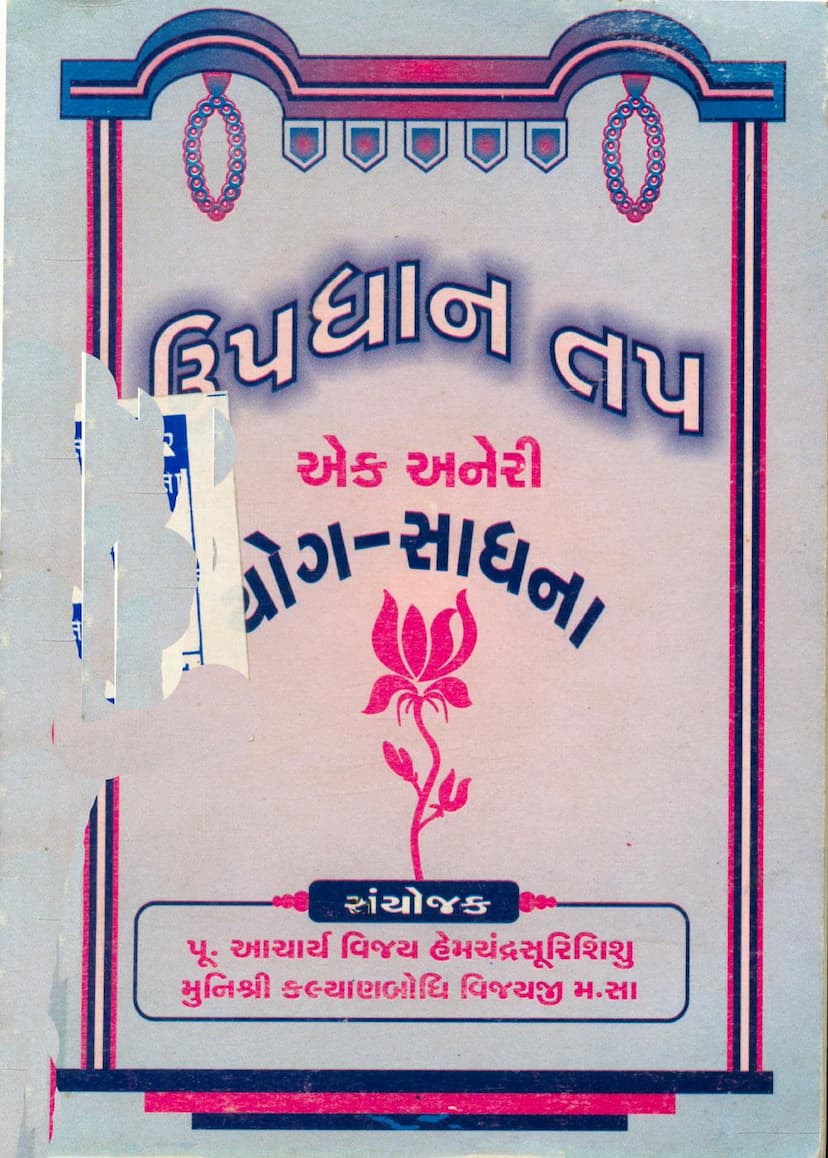Updhan Tap Ek Aneri Yog Sadhna
Added to library: September 2, 2025

Summary
This document, "Updhan Tap Ek Aneri Yog Sadhna" by Kalyanbodhivijay, published by Ambalal Ratanchand Jain Dharmik Trust, is a detailed guide to the Jain practice of Upadhan.
What is Upadhan?
The core concept of Upadhan is explained as a process to detach from worldly distractions and achieve closeness to the soul. It is a form of Yogodvahan (carrying the practice of Yoga), which is a prerequisite for monks to study certain sacred scriptures. For lay practitioners (shravaks and shravikas), Upadhan is a path to purification of body (through Tap), mind (through Jap), and life (through Kriya), leading to a purified soul and mastery over scriptures.
Types of Upadhan:
The text outlines six specific Upadhans for lay practitioners, each dedicated to a particular set of Jain scriptures:
- Panchamangal Mahashrutkandh (Navkar Mantra): 18 days, involving 12 upavasa (fasts).
- Pratikraman Shruthkandh (Irriyavahi, Tass Uttari): 18 days, involving 12 upavasa.
- Shakrastava Adhyayan (Namuththunam): 35 days, involving 3 upavasa and 32 ayambil (a specific type of fasting with reduced ingredients).
- Chaityastava Adhyayan (Arihant Cheiyano, Anantya): 4 days, involving 1 upavasa and 3 ayambil.
- Namastavastava Adhyayan (Logass): 28 days, involving 3 upavasa and 25 ayambil.
- Shrutstav-Siddhstav (Pukharvar Divede, Siddhano Buddhano, Vaiyavachgarano): 10 days, involving 1 upavasa and 5 ayambil (and another upavasa).
The total duration for all six Upadhans is 110 days, with a total of 60 upavasa.
Evolution of Upadhan Practices:
The text highlights a significant difference between historical and contemporary Upadhan practices. Originally, Upadhans involved primarily upavasa and ayambil. However, due to perceived difficulties for practitioners with less spiritual fortitude, modifications were introduced. These included replacing ayambil with nivi (a less strict form of fasting) and adjusting the number of days and fasts. While the intention was to make the practice accessible, the author notes that some of the original spirit and rigor might have been diluted.
Daily Routine and Conduct:
The book provides meticulous guidelines for daily activities during Upadhan:
- Morning Rituals: Waking up early, performing specific prayers and recitations, seeking permission from the Guru for various actions like padilehan (cleaning of essential items), and undertaking kausgg (meditative posture).
- Evening Rituals: Similar to morning rituals, focusing on evening prayers, seeking permission, and observing specific conduct.
- Fasting Procedures: Details on how to break fasts (parna) and the specific rules for nivi and ayambil.
- General Conduct: Emphasis on strict adherence to Jain principles like non-violence (ahimsa) in all actions, careful movement to avoid harming living beings, speaking with muh-patti (mouth covering), maintaining purity, controlling senses, refraining from worldly conversations, and seeking permission for all activities.
- Tools and Equipment: A list of essential items for practice, including katasanu (a mat), charvalo (sweeper), muh-patti, clothes, bedding, etc.
- Ayambils and Nivis: Explanations of the differences and the specific rules associated with each.
- Sacred Texts and Recitation: The importance of memorizing and understanding the meaning of various Jain scriptures.
- Penance and Prohibitions: A detailed list of actions that are considered transgressions during Upadhan, such as using unpurified water, eating certain foods, engaging in worldly activities, and the consequences of such transgressions.
- Daily Practices Summary: A breakdown of the daily schedule, including prayers, scripture study, and adherence to vows.
Key Principles Emphasized:
- Discipline and Dedication: The entire practice of Upadhan is framed as a disciplined and dedicated commitment to spiritual growth.
- Purity: Maintaining physical and mental purity is paramount.
- Non-Violence: Strict adherence to ahimsa in all actions.
- Respect for Gurus: Seeking and following the guidance of spiritual teachers is essential.
- Renunciation: Detachment from worldly pleasures and possessions.
- Self-Reflection and Confession: Regularly reflecting on one's actions and confessing any lapses.
- Societal Responsibility: The impact of one's spiritual practice on the Jain community and wider society.
The Importance of Upadhan:
The text quotes from the Mahanishith Sutra to emphasize the critical importance of Upadhan. It states that reciting scriptures without undergoing the prescribed Upadhan is considered a disrespect to the scriptures, the meaning, the Guru, and ultimately, the Tirthankaras. Such actions lead to prolonged suffering in the cycle of rebirth. Therefore, it is strongly advised that those who have learned scriptures without Upadhan should complete it as soon as possible.
Commitments After Upadhan:
Upon completing Upadhan, practitioners are expected to maintain a higher standard of conduct. They become role models and their actions are observed by others. The text stresses the importance of continuing to uphold Jain principles, avoiding sins, and dedicating oneself to spiritual pursuits. It lists various vows and commitments, including dietary restrictions, ethical conduct in business, abstaining from harmful substances and activities, and actively engaging in spiritual practices.
In essence, "Updhan Tap Ek Aneri Yog Sadhna" is a comprehensive manual for undertaking the rigorous yet rewarding spiritual discipline of Upadhan within Jainism, guiding individuals on a path of purification, self-realization, and adherence to the sacred teachings.